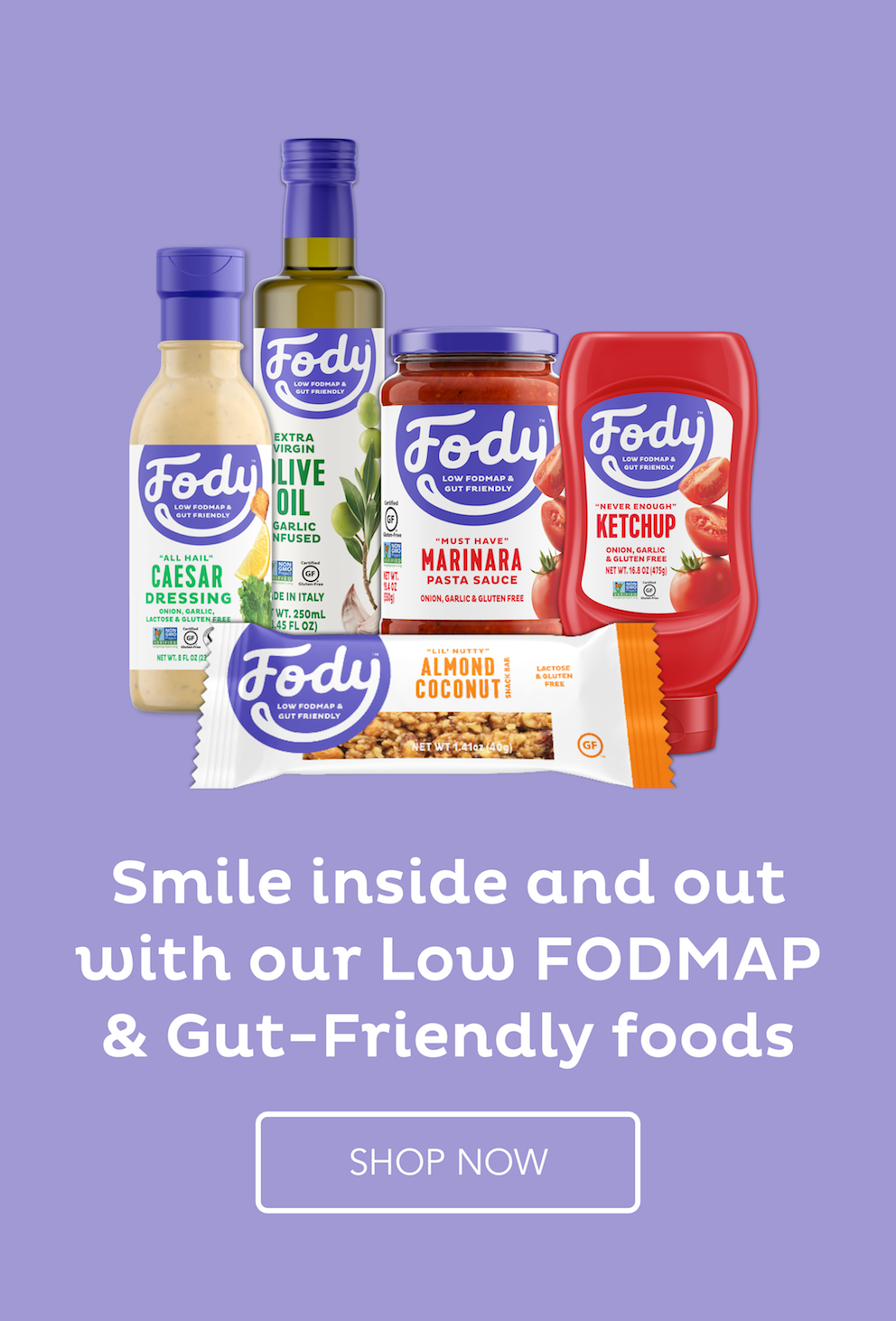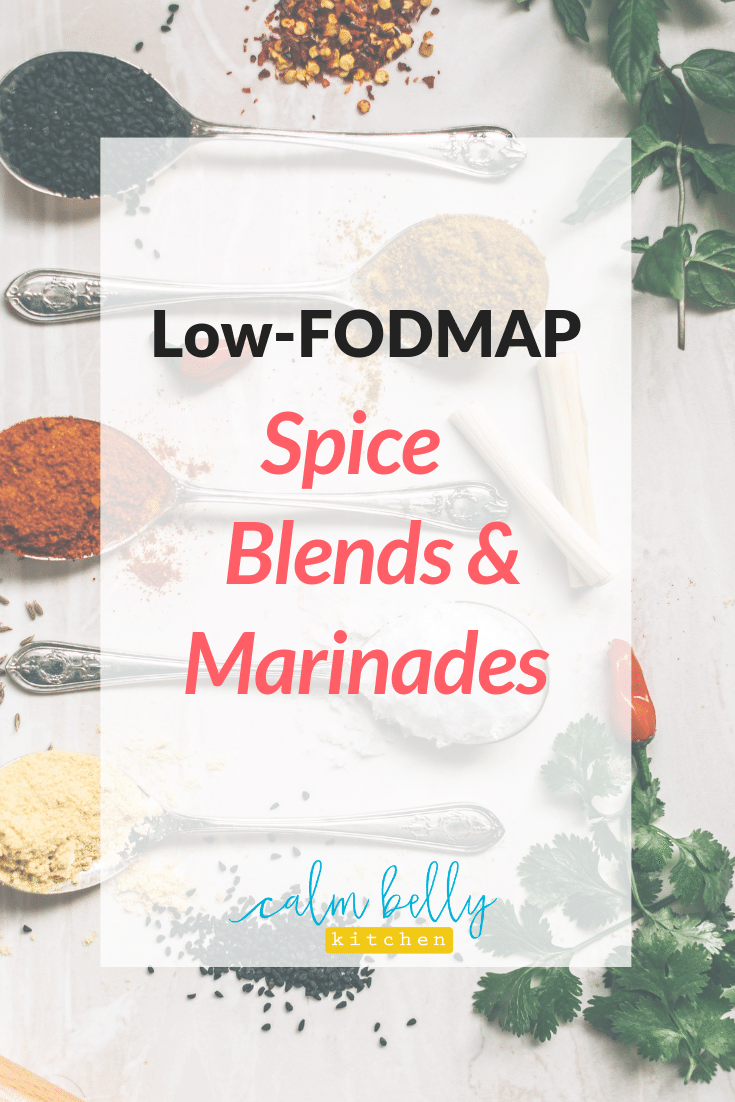What are FODMAPs? The Complete Non-Techy Guide to Eating for IBS
When I first learned about the FODMAP Diet, I was totally overwhelmed. My doctor gave me a short handout and sent me on way.
When I started searching for info online, everything was written in a dry, academic style, and one article would contradict the last. And I certainly couldn’t find any FODMAP recipes that looked appetizing. Not very helpful.
That's why I'm writing this simple, straight-forward, non-techy guide to FODMAPs. Like I'm just talking to you friend-to-friend (because that's what we do here!).
This post is for you if:
You have IBS and want to learn how to relieve your symptoms with diet.
You want a not-too-technical explanation of FODMAPs to give to family or friends.
You want a snazzy graphic to add to your Pinterest board and refer back to anytime (scroll down, my friends!).
>>> Ready to get started today? Click to download our cheat sheets of high and low-FODMAP foods!
In this post, I'll answer the questions:
What is the low-FODMAP diet used for?
What the heck is a FODMAP?
What foods are high in FODMAPs?
How does the low-FODMAP diet work?
Who could benefit from a low-FODMAP diet?
This post is a great overview of what FODMAPs are, but I'll also provide links at the end to resources that go even more in depth.
What are FODMAPs?
What: FODMAP stands for Fermentable Oligosaccharides, Disaccharides, Monosaccharides, And Polyols.
In people with IBS, FODMAPs aren’t easily absorbed in the digestive tract. So they hang around and ferment, causing gas and bloating. They can also absorb water, messing with bowel function and causing diarrhea and/or constipation. Fun.
Who: People with IBS
When: The first research paper on FODMAPs was published as recently as 2005.
Where: Monash University in Melbourne Australia. When other FODMAPers in the Facebook group keep mentioning the “Monash app,” they’re referring the super-useful smartphone app created by researchers there.
Why: Because it improves IBS symptoms in about 75% of people without prescription drugs or expensive treatments.
How: The purpose of the diet is to learn what FODMAP categories trigger your IBS symptoms (and in what portion sizes). The highly restrictive part of the FODMAP diet is NOT meant to be for life.
What is the low-FODMAP diet used for?
The low-FODMAP diet is most often used to make the symptoms of Irritable Bowel Syndrome (IBS), such as stomach pain, diarrhea, constipation, bloating and gas, a lot less miserable in your day-to-day life. It may also help people with other functional gastrointestinal disorders like Inflammatory Bowel Disease (IBD), and it may be part of the dietary treatment for Small Intestinal Bacterial Overgrowth (SIBO).
The diet was developed by researchers at Monash University in Australia in 1999. Since then, studies (including this meta-analysis, or a study of a bunch of previous studies, which was published in May 2015) have shown that it really works to treat IBS .
What does FODMAP stand for?
You asked for it, so here goes:
Fermentable Oligosaccharides, Disaccharides, Monosaccharides And Polyols
But here's the important thing:
FODMAPs are specific types of carbohydrates found in a wide range of foods with one thing in common: For people with gastro-intestinal disorders like IBS, eating high-FODMAP foods in too-large portions or too often can trigger uncomfortable digestive problems.
How much is too much when it comes to FODMAPs? It's different for each of us, so trial and error is key here.
When we're sensitive to a particular high-FODMAP food and eat too much of it, it may not be fully absorbed in the small intestine. When it moves into the large intestine, it causes problems with our digestive process.
The FODMAPs are fermented by the bacteria that live in the large intestine, which causes gas. While they're hanging out in there, they also draw in water, which disrupts normal digestion, leading to bloating, abdominal pain, diarrhea and constipation. The exact symptoms are unique to each of us (and our reactions can change over time too), and alternating between diarrhea and constipation is common.
What foods are high in FODMAPS?
This isn't an exhaustive list (the most complete, up-to-date info is always found on this app), but examples of common high-FODMAP foods in each category. New foods are being tested for FODMAP content everyday!
Oligosaccharides include foods with excess fructans and galactans, such as: garlic, onions, leeks, beans, artichokes, dried fruits, plums, watermelon, wheat, rye, barley, pistachio and cashew nuts, as well as inulin (also called chicory root), a plant fiber often added to vitamins and supplements and low-fat foods like yogurt.
Click to read our Complete Guide to Flavor without Onion and Garlic
The Good News>>>>Not all nuts are high-FODMAP. Peanuts, walnuts and pecans, along with moderate portions of almonds, are low! Also, the green parts of scallions and leeks are low-FODMAP and can add onion flavor to your recipes.
Disaccharides include high-lactose foods such as: milk and yogurt.
The Good News>>>>Many dairy products are low in FODMAPs! You can enjoy hard or aged cheeses like parmesan, brie, cheddar and feta, as well as small servings of ricotta.
Monosaccharides are found in foods with excess fructose such as: asparagus, sugar snap peas, apples, fresh figs, cherries, mangos, pears, watermelon, honey, agave and high fructose corn syrup.
The Good News>>>>Pure maple syrup is an excellent replacement for honey. In baking, cooking and even cocktail-making, maple syrup is a 1-to-1 substitute.
Polyols are found in fruits and vegetables like apples, peaches, blackberries, mushrooms and snow peas, as well as sweeteners like mannitol, sorbitol, maltitol, xylitol and isomalt. These sweeteners can be found in medications and various sugar-free products (some sneaky examples are chewing gum, cough drops and mints).
The Good News>>>>Since the sweeteners in the polyol group are often used in sugar-free and processed foods, sticking to fresh, whole foods makes them easier to avoid.
I put the whole section you just read into a handy infographic for you to share on Pinterest! >>>>Go ahead and PIN IT! (Thank you!)
How does the low-FODMAP diet work?
You don't have to stop eating FODMAPs forever (If you love pizza as much as I do, that's great news!). Instead you cut out certain foods for a short time, bring 'em back and test your tolerance, and build your individual life-long eating plan from the knowledge you gain.
The Three Phases of the FODMAP Diet
Phase 1: Elimination>>>You eliminate high-FODMAP foods from your diet. The goal is to see a consistent improvement in your symptoms, confirming that you are definitely sensitive to FODMAPs. This usually takes 4 to 8 weeks.
Click to read our Ultimate Guide to Making Your Favorite Recipes Low-FODMAP
Phase 2: Reintroduction>>>You test the different types of FODMAPs to see which ones trigger YOUR unique symptoms. Yes, you are a one-of-a-kind snowflake. You’ll slowly increase the portion size of the test foods so you learn the amounts you can tolerate. This generally takes 8 weeks.
Phase 3: The Real-Life Phase >>> This non-official phase is part of my Calm Belly Method. Since FODMAP is a learning diet, you'll keep experimenting and create your unique happy-belly eating style for the long term. Here’s what I help my clients do in Phase 3:
Add high-FODMAP foods that aren’t triggers back to your diet to build confidence
Learn to consistently enjoy even your trigger foods in serving sizes you can tolerate
Travel and have fun in social situations while keeping your belly calm
Go to restaurants without stressing over your order
Many people find out that just one or two particular FODMAPs trigger their symptoms. Everyone is different, so the only way to know is to test out foods for yourself.
The ultimate goal is to have as much variety in your diet as possible while feeling good and keeping your belly happy. This diet is not about a life of deprivation - it's about learning your body's unique needs!
Who could benefit from the low-FODMAP diet?
If you've been diagnosed with IBS, there's a good chance the low-FODMAP diet could help you keep your not-fun digestive issues under control. The most commonly quoted stat is that 76% of IBS patients on a low-FODMAP diet reported satisfaction with their symptoms, especially bloating, abdominal pain and gas. This was a fairly small study, and you can read more about it here.
Now, let's just say you think you have IBS but haven't yet discussed it with a doctor. There are a few reasons why you should see a medical pro before starting your own low-FODMAP adventure:
A doctor can rule out any other conditions that may be causing your symptoms.
A doctor can test you for SIBO (small intestinal bacterial overgrowth), which often looks like IBS and sometimes overlaps with it.
A doctor can test you for celiac disease. For accurate results, you need to do this test while gluten is still a part of your diet. The low-FODMAP diet restricts wheat, which is a major source of gluten for most of us. Gluten itself is not high-FODMAP.
A doctor may be able to refer you to a dietitian who can guide you through the low-FODMAP diet.
If you've gotten the go-ahead to try the low-FODMAP diet from an M.D., you have little to lose and only knowledge to gain!
Your next steps
Get diagnosed by a doctor, if you haven't already.
Join my email crew! Every week, I'll send you tips, inspiration and other cool stuff that you won't find on the blog.
Keep learning. Below, I put together a few links that can take you deeper into the topics I covered here.
Browse through my past blog posts or check out the Calm Belly Kitchen Cookbook to find new low-FODMAP recipes to try. Eating low-FODMAP does NOT need to be boring!
Check out our ebooks for an in-depth guide to all aspects of the FODMAP Diet.
Keep Learning!
The Monash University FODMAP blog. Monash is the leader in FODMAP research and their blog is frequently updated and very helpful.
The Monash University FODMAP App. This is the most reliable, up-to-date FODMAP food list (new foods are being tested every day), and it will make your life so much easier! I use it all the time to check foods and portion sizes when I write recipes and plan my meals.
An easy to understand, but slightly more technical guide to FODMAPs by Dr. Sue Shepherd.
A round-up of 25 low-FODMAP recipes you can take to work from a bunch of amazing bloggers (and me!).
















